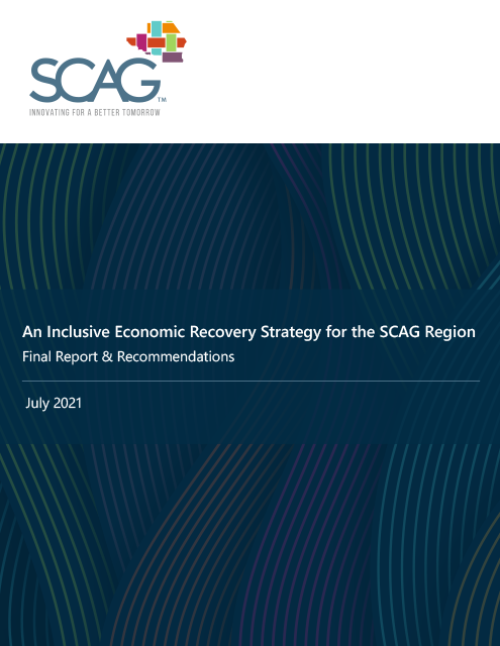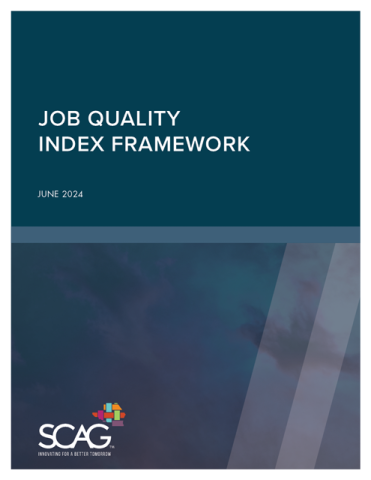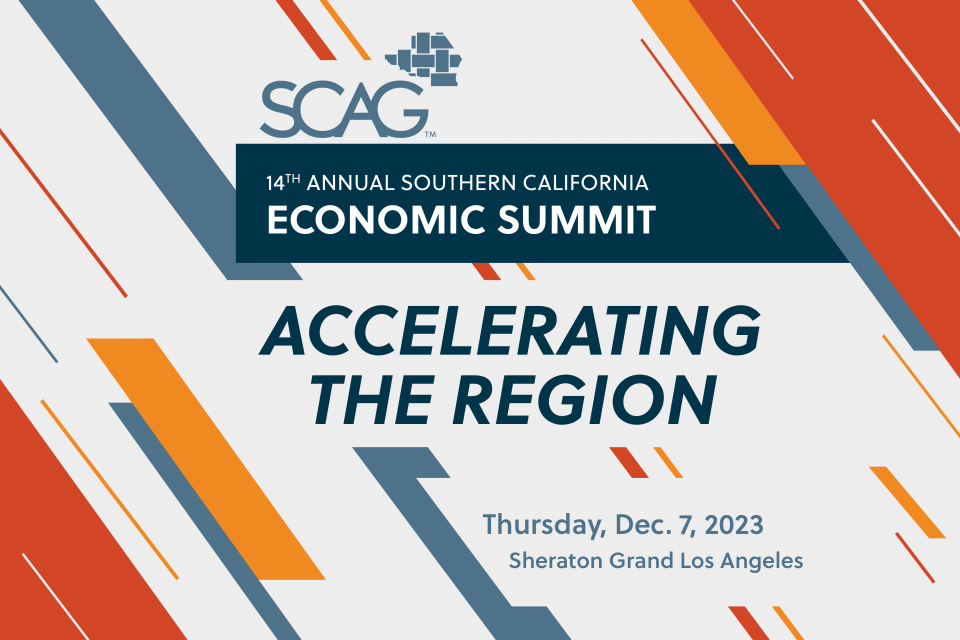Our Work
- Connect SoCal
- Inclusion, Diversity, Equity & Awareness
- Programs & Projects
- Housing
- Economy & Demography
- Federal & State Compliance
- Sustainable Development and Resilient Communities
- Transportation
- Active Transportation
- Planning For Main Streets
- Aviation Program
- Regional Pilot Initiatives Program
- Future Communities Pilot Program
- Transportation Demand Management
- Transit Program
- FreightWorks
- Passenger Rail Program
- Corridor Planning
- Transportation Safety
- Transportation Finance
- Intelligent Transportation Systems
- Southern California Transportation Study
- LA28 Games Mobility Program
- Local Resources
- Funding & Programming
- Legislation & Advocacy
- Publications & Reports
Economy & Demography
Get the latest information on SCAG’s Southern California economic and demographic data, along with analysis and resources.
- Related Links & Resources
Imperial Valley Economic Development Corporation
The Imperial Valley Economic Development Corporation is a partnership between Imperial County, local cities, elected officials and utilities, united by the common vision of expanding and diversifying the regional economy.Inland Empire Economic Partnership
The Inland Empire Economic Partnership is the area’s only regional economic development organization, which works closely with business and government leaders to make the Inland Empire a great place to live, work and invest.Orange County Business Council
For over 25 years, Orange County Business Council has been the leading voice of business reinforcing the economic influence of Orange County.Southern California Leadership Council
Formed to meet this challenge, the Southern California Leadership Council was founded in 2005 as a non-partisan, non-profit, business-led public policy partnership of business and community leaders.

The Inclusive Economic Recovery Strategy (IERS) identifies ways SCAG can work with local partners to foster inclusive economic prosperity as the region continues to recover from the economic and social disruptions of the COVID-19 pandemic.
In spring 2022, with support from State Senator Susan Rubio, SCAG received one-time grant funding from the California Workforce Development Board to implement several core recommendations from the IERS and to guide SCAG’s efforts in advancing inclusive economic growth.
SCAG developed the IERS as an activity of the Racial Equity Early Action PlanRacial Equity Early Action Plan in collaboration with stakeholders and practitioners, focusing on recommendations that SCAG is well positioned to lead or implement with an appropriate partner. The SCAG Regional Council adopted “An Inclusive Economic Recovery Strategy for the SCAG Region” report and recommendations on July 1, 2021.
The inclusive report will help SCAG further explore the integration of policy goals related to economic growth in the development and adoption of the Connect SoCal Regional Transportation Plan/Sustainable Community Strategy every four years.
- Apprenticeships: Expanding Economic Opportunities in Southern California
- Addressing Barriers to Economic Opportunity
- Inclusive Contracting Toolkit
- Good Data, Stronger Tribes: Overcoming Native American Data Challenges in Southern California
The “Apprenticeships: Expanding Economic Opportunities in Southern California” report explores how apprenticeship programs can address workforce gaps and provide meaningful, debt-free pathways for job training and employment opportunities.
As California sets a goal of expanding support to 500,000 apprenticeships by 2029, the report features best practices and case studies from across Southern California, covering both traditional and emerging industries like construction, transit, healthcare, and advanced manufacturing. Key strategies for success include employer engagement, strong mentorship, and competitive pay structures. The report also offers policy recommendations to streamline program development, expand public sector participation, and raise awareness of apprenticeships as a long-term workforce solution.
Download the “Apprenticeships: Expanding Economic Opportunities in Southern California” report.
The “Addressing Barriers to Economic Opportunities” report identifies and quantifies structural challenges that limit access to economic opportunity across Southern California. Key barriers identified include lack of affordable housing, limited access to reliable and affordable transportation, skills mismatch, and inadequate access to affordable child and family care.
These challenges disproportionately impact Black, Indigenous, and People of Color, youth under 25, and people with disabilities. Despite high automobile access, nearly 85 percent of jobs in the region remain out of reach within a 45-minute commute. The report offers actionable policy recommendations—such as universal basic mobility programs, targeted infrastructure investments, and workforce-centered planning—to help expand access to opportunity and promote regional equity.
To supplement the research and recommendations from this report, SCAG also compiled county-level profiles for Imperial County, the Inland Empire, Los Angeles County, Orange County, and Ventura County—highlighting how key stakeholders in each are working to address barriers and expand economic opportunity.
Download the “Addressing Barriers to Economic Opportunity” report.
The Inclusive Contracting Toolkit is a roadmap with actionable recommendations for procurement professionals in public agencies and private anchor institutions to implement inclusive contracting policies, programs, and practices. The toolkit includes a library of best practices and recommendations that reflect the range of emerging and promising inclusive contracting methods.
Recognizing all organizations approach procurement uniquely, the Inclusive Contracting Toolkit provides insights into inclusive contracting by summarizing context, recommending immediate actions, and presenting proven tactics. The toolkit outlines policies, discusses challenges, suggests implementation steps, and provides real-world examples within the SCAG region. Moreover, it differentiates recommendations relevant to public agencies and private institutions and includes successful case studies from initiatives across the country.
The toolkit’s development included a thorough literature review and engagement with industry professionals and small business organizations. The Inclusive Contracting Technical Advisory Committee and industry focus groups provided invaluable insights, to firmly root the toolkit in the realities and opportunities currently facing procurement professionals in the SCAG region.
Download the Inclusive Contracting Toolkit.
The “Good Data, Stronger Tribes: Overcoming Native American Data Challenges in Southern California” report examines persistent barriers to reliable data for Native American Tribes in the SCAG region and outlines a regional roadmap for change. Reliable data are essential for effective policymaking and community wellbeing, yet Native American Tribes face persistent data challenges that undermine Tribal governance and sovereignty.
The report draws on over 30 interviews and site visits with Tribal leaders and stakeholders in the SCAG region. It identifies five core data limitations affecting Tribes—including small sample sizes, misclassification, and limited access. The report also highlights six insights from Tribal leaders in the SCAG region ranging from the need for more accurate population and land data to the critical role of data in accessing funding and supporting self-governance. It then recommends a four-part framework for action to improve Tribal data resources and capacity—including supporting Tribal sovereignty by increasing access to and control over data and building Tribal data capacity through funding, tools, and training.
Download the “Good Data, Stronger Tribes: Overcoming Native American Data Challenges in Southern California” report.
As the official Southern California affiliate of the U.S. Census Bureau, SCAG compiles detailed demographic data for the region and tracks new data releases, many of which are used in developing growth projections for Connect SoCal.
- 2025 Southern California Economic Update
- Economic Roundtable
- Regional Growth Forecasting
- State Census Data Center Updates and Releases
- Job Quality Index
- Research Reports & Findings
Economic Roundtable
Since 2009, SCAG has convened a team of independent economists representing the region’s counties and key specialty areas to collaborate with SCAG expert staff to assess the economic landscape of the Southern California region. In 2022, the renamed “Economic Roundtable” began meeting quarterly to discuss trends, data and current events impacting the region’s economy. Quarterly reports can be found below and on the SCAG news feed, and all accompanying economic data for the region can be visualized on and exported from the SCAG Economic Trends Tool.
Economic Roundtable Updates
Economic Roundtable Members:
Imperial County
- Michael Bracken, Development Management Group, Inc.
Los Angeles County
- Shannon Sedgwick, Los Angeles County Economic Development Corporation
Orange County
- Wallace Walrod, Tech Coast Consulting Group and Orange County Business Council
Riverside and San Bernardino Counties
- Manfred Keil, Inland Empire Economic Partnership and Claremont McKenna College and Robert Kleinhenz, IEEP and Kleinhenz Economics
Ventura County
- Mark Schniepp, California Economic Forecast
Sustainability
- David Roland-Holst, Berkeley Economic Advising & Research and University of California, Berkeley
Equity
- Beth Tamayose, University of California, Riverside
Regional Growth Forecasting
SCAG develops a three-decade projection of population, household, and employment growth every four years for Connect SoCal at the region, county, jurisdiction, and Transportation Analysis Zone levels. Unlike a short-run projection, which depends heavily on economic cycles, long-run regional growth is driven by births, deaths, migration and the composition of the region’s industries relative to the rest of the country. The growth forecast process begins by convening a demographic panel of experts. Local jurisdictions provide, review and integrate project-level information through the Local Data Exchange process.
The latest growth forecast data and technical details can be found in Connect SoCal Demographics & Growth Forecast Technical Report and in agendas from SCAG’s Technical Working Group.
State Census Data Center Updates and Releases
SCAG is the officially designated Southern California affiliate to the State Census Data Center program. Statewide program information and data releases are available online through the California Department of Finance. SCAG provides brief updates and analysis on the most up-to-date population, housing, and socioeconomic trends when new data are released. Data are regularly integrated into the regional plan development process.
- American Community Survey 2024 Data Release
- American Community Survey 2023 Data Release
- American Community Survey 2023 Data Release
- Quarterly Update Feb. 1, 2024
- American Community Survey 2022 Data Release
- American Community Survey 2021 Data Release
Job Quality Index
To create a new benchmark of understanding for the region’s job markets, SCAG has published the Job Quality Index Framework (JQI) as both a report and a database. SCAG first proposed development of a county-level job quality index for the region in the Inclusive Economic Recovery Strategy (IERS) report (2021). The state of California awarded a one-time state grant, with support from State Senator Susan Rubio (D-District 22), for SCAG to implement the IERS, including development of the Job Quality Index.
The JQI can inform policy decisions and measure progress toward a more resilient, inclusive and equitable economy for Southern California, as outlined in Connect SoCal 2024. SCAG’s Job Quality Index is weighted by the findings of a survey of 2,900 workers across demographic groups and geographic locations in Southern California. Policymakers and business leaders can benefit from a clearer understanding of what workers want from jobs to improve sector competitiveness and workplace conditions, while workers can also benefit from improvements that contribute to their quality of life.

Research Reports & Findings
- Southern California Economic Updates
SCAG publishes an annual economic update with analysis covering the entire region as well as providing specific insight into the economies of Los Angeles, Orange, Ventura, San Bernardino, Riverside, and Imperial counties.
Download the “2024 Southern California Economic Update.”
- Economic Impacts of Equity
The “Economic Impacts of Equity” report measures the economic effect of wage gaps between racial and gender groups and the potential benefit of closing those gaps. Read the full report online.
- Considerations for Regional and Subregional Forecasting in California
SCAG worked with the Population Reference Bureau to develop the “Considerations for Regional and Subregional Forecasting in California” white paper.
- Regional Briefing Book
The “Regional Briefing Book” was SCAG’s comprehensive annual report and near-term outlook on Southern California’s economic landscape for 2023 and was shared at the annual 14th Annual Economic Summit.
2025 Southern California Economic Update
The “2025 Southern California Economic Update” was presented during the SCAG Joint Policy Committee Meeting on Dec. 4, 2025. The annual presentation provides a comprehensive overview of the region’s economic performance and outlook, with analysis of informed decision-making among Southern California’s local and regional policymakers.
This update featured an in-depth look at the SCAG region’s economy, which captures key dynamics shaping Southern California’s growth. The analysis examines wages and consumer spending, taxable sales, and labor market trends, while exploring shifts in demographics, household income, and patterns of new development.
This year’s update also included a special economic impact analysis of the upcoming 2028 Summer Olympic and Paralympic Games, which estimates the economic output and job creation potential of Games-related spending and investments on the six counties of the SCAG region.
Resources from the event are now available:
- Download the “2025 Southern California Economic Update”
- Download the Event Presentation
- View the Video Recording of the Presentation

As the official Southern California affiliate of the U.S. Census Bureau, SCAG compiles detailed demographic data for the region and tracks new data releases, many of which are used in developing growth projections for Connect SoCal.

